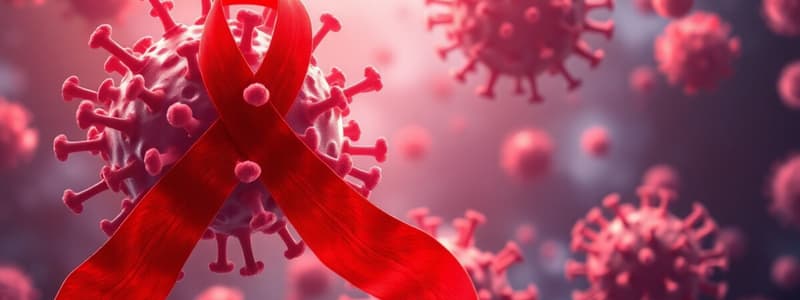Podcast
Questions and Answers
Why is HIV-1 more commonly associated with AIDS cases compared to HIV-2?
Why is HIV-1 more commonly associated with AIDS cases compared to HIV-2?
- HIV-2 primarily targets B cells, which have a limited role in AIDS progression.
- HIV-1 only replicates in individuals with specific genetic markers
- HIV-1 exhibits higher transmissibility and global prevalence compared to HIV-2. (correct)
- HIV-2 is effectively cleared by the immune system before progressing to AIDS.
How do heterozygous mutations in the CCR5 co-receptor typically affect HIV infection?
How do heterozygous mutations in the CCR5 co-receptor typically affect HIV infection?
- They provide complete immunity to HIV infection.
- They can slow down the progression of the disease. (correct)
- They have no impact on HIV infection or disease progression.
- They accelerate the progression of HIV to AIDS.
During HIV replication, what is the primary role of the reverse transcriptase enzyme?
During HIV replication, what is the primary role of the reverse transcriptase enzyme?
- To transcribe proviral DNA from viral RNA. (correct)
- To integrate viral RNA directly into the host cell's genome.
- To cleave viral proteins into functional units.
- To facilitate the binding of the virus to CD4+ cells.
In the context of HIV infection, what determines viral tropism?
In the context of HIV infection, what determines viral tropism?
Why is the R5 strain of HIV significant in the early stages of acute infection?
Why is the R5 strain of HIV significant in the early stages of acute infection?
What immunological hallmark typically defines the transition from HIV infection to AIDS?
What immunological hallmark typically defines the transition from HIV infection to AIDS?
Which of the following is an AIDS-defining condition?
Which of the following is an AIDS-defining condition?
In regions with limited resources, which mode of HIV transmission is more prevalent?
In regions with limited resources, which mode of HIV transmission is more prevalent?
Why are antibody/antigen combination tests recommended for initial HIV screening?
Why are antibody/antigen combination tests recommended for initial HIV screening?
How does antiretroviral therapy (ART) primarily benefit individuals with HIV?
How does antiretroviral therapy (ART) primarily benefit individuals with HIV?
Flashcards
HIV
HIV
Human immunodeficiency virus; targets immune cells, leading to immunodeficiency and increased risk of infections/tumors (AIDS).
HIV-1 vs. HIV-2
HIV-1 vs. HIV-2
HIV-1 is more common worldwide and the predominant cause of AIDS.
HIV Attachment
HIV Attachment
HIV uses its gp120 protein to attach to the CD4 molecule on target cells, such as T-helper cells and macrophages.
HIV Co-receptors
HIV Co-receptors
Signup and view all the flashcards
CCR5 homozygous mutations
CCR5 homozygous mutations
Signup and view all the flashcards
Reverse Transcriptase
Reverse Transcriptase
Signup and view all the flashcards
Viral Tropism
Viral Tropism
Signup and view all the flashcards
HIV Testing
HIV Testing
Signup and view all the flashcards
Antiretroviral Therapy (ART)
Antiretroviral Therapy (ART)
Signup and view all the flashcards
HIV Transmission
HIV Transmission
Signup and view all the flashcards
Study Notes
No new information was provided; therefore, the study notes are identical to the original ones.
HIV Overview
- HIV (human immunodeficiency virus) targets cells of the immune system, leading to immunodeficiency.
- Immunodeficiency increases the risk of infections and tumors, which are referred to as AIDS (acquired immunodeficiency syndrome).
- Two main types of HIV exist: HIV-1 and HIV-2.
- HIV-1 is more common worldwide and in the US, predominantly associated with AIDS.
- HIV-2 is rarer and mostly found in western Africa and southern Asia.
- "HIV" typically refers to HIV-1 due to the rarity of HIV-2.
Cellular Targets and Mechanisms
- HIV targets CD4+ cells, which include macrophages, T-helper cells, and dendritic cells.
- The CD4 molecule is crucial for immune cell attachment and communication.
- HIV uses its gp120 protein to attach to the CD4 molecule on target cells.
- HIV also requires a co-receptor (CXCR4 or CCR5) to enter the cell.
- CXCR4 co-receptors are mainly found on T-cells.
- CCR5 co-receptors are found on T-cells, macrophages, monocytes, and dendritic cells.
- Individuals with homozygous mutations in CCR5 may have resistance or immunity to HIV.
- Heterozygous mutations in CCR5 can slow disease progression.
- HIV is a single-stranded, positive-sense, enveloped RNA retrovirus.
- It uses reverse transcriptase to create proviral DNA from its RNA.
- The proviral DNA integrates into the host cell's DNA in the nucleus.
- Immune cell activation inadvertently transcribes and translates new HIV viruses.
Viral Tropism and Infection Phases
- HIV is prone to making errors during replication, leading to different strains with varying behaviors.
- Viral tropism refers to the host cell preference of these HIV strains.
- The R5 strain of HIV, which binds to the CCR5 co-receptor, infects macrophages, dendritic cells, and T cells early in the acute infection.
- Dendritic cells capture the virus and migrate to lymph nodes, leading to high viral replication.
- Acute infection symptoms resemble flu or mononucleosis.
- The immune system responds, controlling viral replication, and the patient enters the chronic or clinically-latent phase, with lower, detectable viral levels by 12 weeks.
- The chronic phase can last 2-10 years, with a slow increase in viruses and a decrease in T cells.
- During the chronic phase, T cell counts are usually above 500 cells / mm3.
Disease Progression and AIDS
- Some patients develop an X4 strain of HIV during the chronic phase which targets the CXCR4 coreceptor, primarily found on T-cells.
- X4 strains can destroy CD4 T cells in lymphoid tissues.
- Lymphadenopathy and minor infections like oral hairy leukoplakia and oral candidiasis occur when T cell counts drop to 200-500 cells / mm3.
- AIDS is diagnosed when T cell levels fall below 200 cells / mm3, indicating a severely compromised immune system.
- AIDS symptoms include persistent fever, fatigue, weight loss, and diarrhea.
- AIDS-defining conditions include recurrent bacterial pneumonia, pneumocystis pneumonia, candidiasis of the esophagus, Kaposi sarcoma, and primary lymphoma of the brain.
- Death in AIDS patients often results from infections that a healthy immune system could manage.
Transmission and Diagnosis
- Male-to-male transmission is the most common mode in the US.
- Male-to-female transmission is more common in resource-limited settings.
- HIV is present in vaginal and cervical fluids, allowing for female-to-male transmission.
- Sexual intercourse accounts for over 75% of HIV cases.
- Other transmission routes include intravenous drug abuse and mother-to-child transmission (via placenta, delivery, or breast milk).
- Less common modes include accidental needlesticks and blood transfusions.
- HIV tests include antibody tests, antibody/antigen tests, and RNA/DNA tests.
- Antibody tests detect antibodies against HIV.
- Antigen tests and RNA/DNA tests directly detect the virus.
- Antibody/antigen tests are recommended for screening due to their ability to identify early infections.
- A confirmatory test (antibody or nucleic acid test) is recommended following a positive screening test.
Treatment
- There is currently no cure for AIDS.
- Antiretroviral therapy (ART) can prolong life, improve health, and reduce transmission risk.
- ART involves a combination of medicines, known as an HIV regimen.
- ART slows HIV replication, allowing the immune system to recover and fight off infections.
Studying That Suits You
Use AI to generate personalized quizzes and flashcards to suit your learning preferences.





